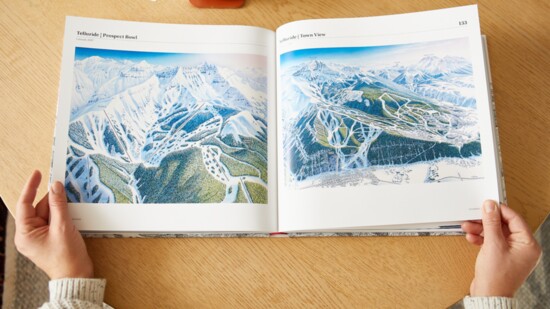As you unfold a ski map at your favorite resort, tracing the trails with eager anticipation, have you paused to consider the artistry behind it? These maps are the product of intricate craftsmanship, blending precision and creativity to transform vast mountain landscapes into clear, captivating visuals. Each map holds a story of meticulous design that deserves a closer look.
Ski map-making is a craft that intertwines art, science, and adventure. These maps are vibrant depictions of the landscapes that draw skiers and outdoor enthusiasts to their snowy peaks. Behind these intricate illustrations is a tradition of hand-painted beauty, where legendary cartographer James Niehues has established himself as a master. His legacy now passes to artists like Rad Smith, who, while carrying the torch of this unique art form, are also finding ways to evolve the craft.
James Niehues began painting aerial views in 1986, but it was in 1988 that he first took on the challenge of creating ski maps. Over the course of his career, he has painted more than 350 views for ski resorts, tourist bureaus, and outdoor-related industries worldwide. Each view is meticulously crafted using opaque watercolor with brush and airbrush, capturing the nuances of the natural world.
Niehues, a self-described "farm boy from rural Colorado," recalls how he began working on ski maps by chance after moving to Denver. "It was incredibly fortunate timing when I connected with renowned trail map painter Bill C. Brown," Niehues says. Brown, who was close to retirement, passed on some of his clients to Niehues, allowing him to hone his skills and build a portfolio.
One of the key challenges of ski map making, as Niehues notes, is finding the perfect moment to capture the mountain's essence. "My favorite part of the process has been determining what time of day a mountain looks its best. I'm looking at the angles of the shadows and which cardinal direction the mountain faces," Niehues explains. The shadows are crucial because they provide depth and realism, making the image not only functional but dynamic and alive.
Niehues' maps are more than just functional guides—they have become pieces of art in themselves, admired by the ski community for decades. Following the publication of his book by Open Road Ski Company, "The Man Behind the Maps," he was overwhelmed by the positive response from fans: "After three decades of painting ski resorts, it's just extremely gratifying to know that there are people out there that still appreciate my work and enjoy using it when they visit the mountains."
As Niehues steps away from ski map making, he has found a kindred spirit in Rad Smith, an artist who has embraced both traditional and digital methods in his work. While Smith has been creating maps for years, his collaboration with Niehues has profoundly impacted his evolution as an artist.
"When I first reached out to him, it was a slow start," Smith recalls. "I was working full-time as an illustrator and graphic designer in the environmental consulting community, so I couldn't jump into it full-time." However, Niehues' mentorship, offering not just technical advice but ongoing encouragement, was invaluable. "He was always very forthcoming with information and answering questions," says Smith.
One of the biggest challenges Smith faced was transitioning from digital to hand-painted maps. Ski resorts, especially those who commission these works, often want a specific "look and feel" reminiscent of Niehues' style. But Smith has worked hard to find his own voice. "Initially, I was certainly using a lot of his stylistic techniques. I love his work, so it was hard for me not to be influenced heavily by the look and feel that he had created," says Smith. "If I'm repainting an area that [Niehues] has painted previously—10 or 15 years ago— it's a challenge. But at the same time, I feel like it's my painting; it's going to be unique."
Like Niehues, Smith follows a meticulous process that starts with gathering references, often including drone footage or, when possible, visiting the resort in person. The importance of these visual references can't be overstated. Smith has also adopted Niehues' approach of creating a simple line draft, which he shares with the client for feedback before moving on to a more detailed pencil sketch and, finally, the full painting.
"There's a lot of faith in the process," Smith admits, referring to the complex layering of elements—like shadows and trees—that must come together perfectly in a finished piece. Niehues also reflects the necessity of communication and confidence: "For any artist, communication with the client is of the utmost importance. You also need to trust the process and let the painting evolve."
As Smith continues to build on Niehues' legacy, he is excited about how his style might progress. "One thing I hope to do in the future is include more atmospheric elements," says Smith. "Some of [Niehues'] paintings, some of his clouds…just bring such a look and feel of an area. You really get a sense of place." Inspired by both Niehaus and historic European panoramic painters, Smith wants to continue to bring more artistic expression into his work without losing the realism that ski resorts and skiers rely on for navigation.
"I don't want people to think of it as just a utilitarian tool," Smith says of his maps. "I want it to be something they look at more than once. One thing that both excites me and fascinates me is how passionate some people are about their ski maps… I'm thankful that James helped set that kind of look and feel that so many people have come to expect."
Smith is poised to continue this tradition while staying true to Niehues' high standards, blending artistry and practicality in a way that honors an incredible legacy. For skiers, these maps are pieces of art that preserve memories of their time on the slopes, and with Smith at the helm, the craft of ski map-making promises to inspire generations to come.
JamesNiehues.com
RadSmithArt.com
OpenRoadSki.com
